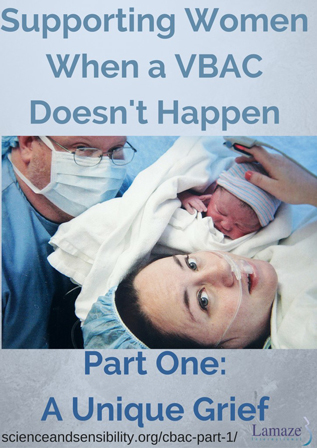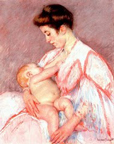Series: Supporting Women When a VBAC Doesn't Happen - Part One: A Unique Grief
By: Sharon Muza, BS, LCCE, FACCE, CD/BDT(DONA), CLE | 0 Comments
By Pamela Vireday
'Although the world is full of suffering, it is also full of the overcoming of it.' - Helen Keller

I am delighted to share with you a three part series that begins today, written by Pamela Vireday, who is an occasional contributor to Science & Sensibility. In this series, Pamela examines the topic of women who experience a Cesarean Birth after a Cesarean. This is when families are planning for a vaginal birth after a prior cesarean, but the birth does not go as planned. The experiences of women who have a CBAC are often negated and their emotional and physical well-being given short-shrift by both professionals and their social community of friends and family. The research on this topic is slim and begs for exploration by qualified investigators. Today, Pamela discusses the unique grief that CBAC women may experience. Part two will examine the limited research available and part three will provide information on how to support CBAC women in the absence of published research. We will also conclude the series with a useful resource list to share with the families you may work with who find themselves in this situation. You can also read a companion piece of Pamela's own personal story, 'Cesarean Birth after Cesarean, 18 Years Later' on her own website.- Sharon Muza, Community Manager, Science & Sensibility.
It is a hard truth that not all women who want a VBAC will have one.
In a typical high-intervention hospital setting, about 60-80% of women who attempt a VBAC will have one. (Grobman 2010) That's a terrific, strong reason to support VBACs.
The underappreciated flip side of this statistic, however, is that about 20-40% of women who attempt a VBAC will have another cesarean instead, often after a long, hard labor. Yet little attention has been paid to these women and their families. How do they feel about their experience? How is their emotional journey different than after a primary cesarean or an elective repeat cesarean? What do these women need to integrate this experience into their lives?
Anecdotally, many women report that they did not feel supported after a VBAC attempt (referred to as TOLAC - Trial of Labor after Cesarean) that ended in another cesarean. Some even felt judged or deserted by their care providers and friends. Research shows that the physical recovery is often harder, too. Yet little attention has been paid in the research to the needs of these women, and few resources exist that directly address their experiences.
Where is the support for women who have an undesired, unplanned second cesarean? Where is the acknowledgement of all the work they put in towards a VBAC, the hours of labor, the pain, the worry? Does all that preparation and work not count if one does not end up with a VBAC?
How can we in the birth field better support the women who do not have a VBAC? How can we helpall mothers feel supported, regardless of outcome?
Terminology
The first thing that we can do is to be mindful of our terminology.
Obstetric research typically uses the terms 'Failed VBAC' or 'Failed Trial of Labor After Cesarean' (Failed TOLAC). Many women feel that this terminology is judgmental and insensitive, adding to their emotional wounds at a time when they feel most vulnerable. Women who did not get a VBAC are not failures. The reality of birth is much grayer than a black-or-white, success-or-failure binary equation.
The term, 'trial of labor cesarean,' is a better alternative than 'failed VBAC.' However, it is cumbersome and perpetuates the mentality of being 'on trial.'
Members of the International Cesarean Awareness Network (ICAN) created the more-neutral term 'Cesarean Birth After Cesarean' (CBAC) as an alternative. It helps distinguish between a repeat cesarean that was gladly chosen and one that occurred when a mother planned and worked for a VBAC but didn't get one.
Most of the time, CBAC refers to a woman who labored and then had a repeat cesarean. However, sometimes CBAC can also refer to an unwanted repeat cesarean performed before labor for legitimate medical reasons, because the mother was coerced or scared into a repeat cesarean, or because she was unable to find a supportive provider. The point is that an undesired cesarean is going to have a different emotional resonance than one which was wanted.
Some women prefer 'CSAC' (Cesarean Surgery After Cesarean). We will use 'CBAC' here because its meaning is intuitive and it is a logical companion term to 'VBAC' but women should choose the term that feels right for their experience.
Women's Stories
Women who have had CBACs often report that they did not receive adequate emotional support from birth professionals, friends, or family after the birth.
'When it comes to support, I had tons when PLANNING the VBAC but once it turned into a CBAC? Everyone disappeared. No one was willing to talk to me about it. No one really had information to GIVE me about a 'failed VBAC.' - Sarah Vincent
'I remember after my failed [VBAC] attempt how much I needed to share my story, talk about my disappointment and sadness, and process what went wrong. But it seemed as though nobody wanted to hear it. It was almost as if my CBAC might be contagious so I should refrain from talking much about it. - Teresa Stire
Personally, I had a CBAC after 5 hours pushing with no progress. My doula made me feel like I had given up too soon. She left soon after the cesarean and I never saw or heard from her again, despite the fact that she was supposed to do a postpartum visit. Her abandonment spoke volumes. Sadly, her judgment was only the first of many from the birth world.
CBAC mothers often feel their decisions are second-guessed like this. Well-meaning people will go through a CBAC mother's birth story, looking for 'wrong' decisions that caused the CBAC. Sometimes CBAC stories are used as cautionary tales to other hopeful VBAC mothers. Even when there are things a CBAC mother might have changed about her decisions, being held up as an example of 'what not to do' is incredibly hurtful.
Furthermore, the grief around a CBAC is different in some ways than that around a primary cesarean; women tend to feel more 'broken' after a CBAC, as if their bodies had truly failed them, and many feel isolated and unsupported. Yet the birth community treats CBACs as if they are no different from primary cesareans. CBAC mothers have shared:
'I personally felt screwed by careproviders after my 1st CS, but after my 2nd I felt screwed by my body' I truly was broken.- Elaine Mills
'The isolation of CBAC is another aspect that may be relatively unknown. I felt very isolated ' from vaginal birth moms, from Elective Repeat Cesarean moms (ERCS) moms, and very much from VBAC moms. This has been very toxic for me.- Rebecca H.
'Validating the compounding nature of that loss (as opposed to a primary c/s) - the nail in the coffin feeling ' is so important.- Caroline Kelley
A CBAC is not experienced in the same way as a primary cesarean or an elective repeat cesarean. The grief resonates differently, even if the CBAC was prudent or necessary. Yet seldom is the unique nature of this loss acknowledged. How can we, as birth professionals, recognize these differences and support these women through this emotional journey? More on this in the Part Two of the series on Tuesday.
References
Grobman, W. A. (2010, August). Rates and prediction of successful vaginal birth after cesarean. InSeminars in perinatology (Vol. 34, No. 4, pp. 244-248). WB Saunders.
About Pamela Vireday

Painting by Mary
Cassatt, 1844-
1926. (public
domain) Image from
Wikimedia
Commons.
Pamela Vireday is a childbirth educator, writer, woman of size, and mother to four children. She has been collecting the stories of women of size and writing about childbirth research for 20 years. She writes at www.wellroundedmama.blogspot.com and www.plus-size-pregnancy.org.
Published: November 04, 2015
Tags
Childbirth educationPostpartumCesareanResearchCesarean SurgeryCBACCesarean BirthFathersLabor/BirthMaternal Infant CareDoulasCesarean SectionImproving teaching skillsbetter birth outcomesPamela ViredayParent educationPam Viredaysocial supp